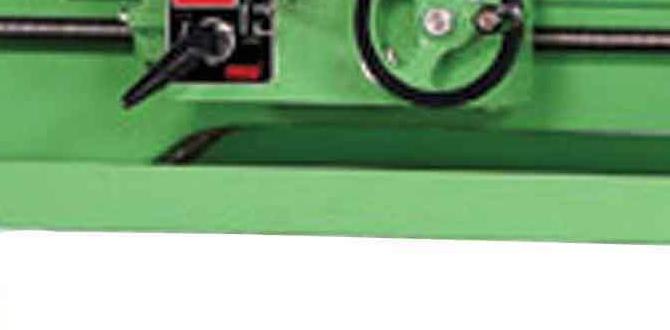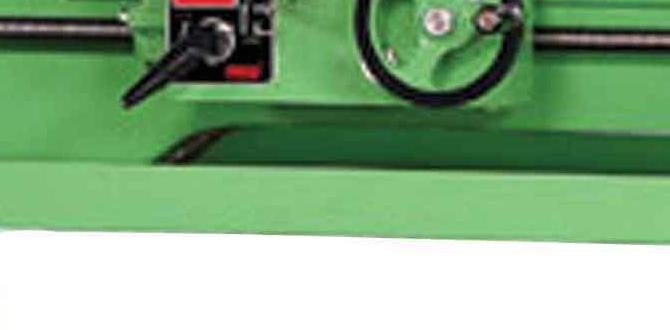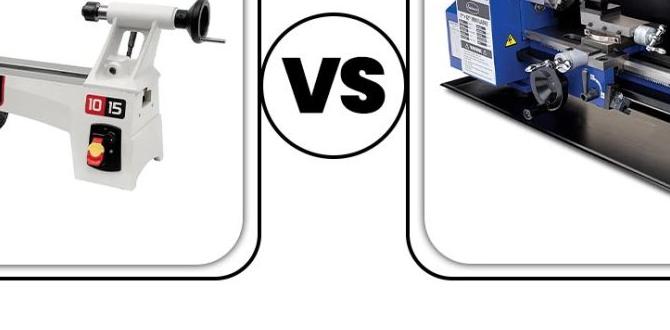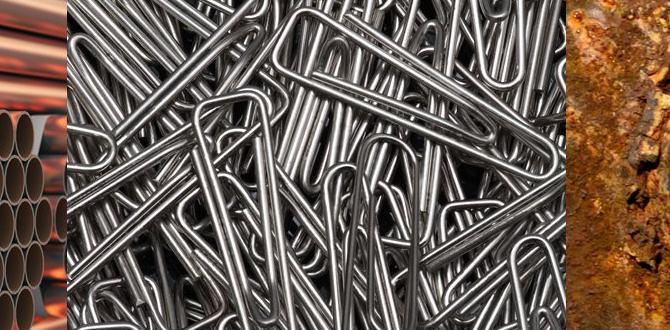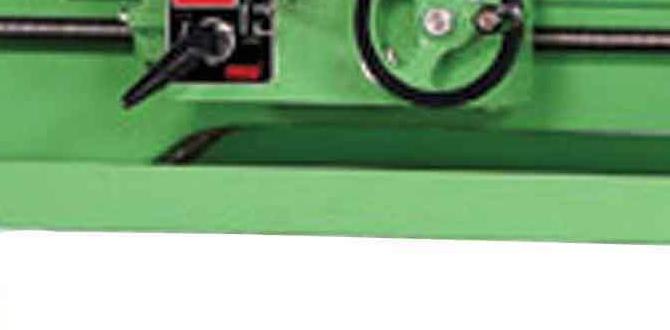Quick Summary
A mini wood lathe dust extractor captures wood dust right at the source, keeping your workspace cleaner and healthier. Setting up a DIY or purchasing a commercial unit ensures better air quality and protects your lungs from fine particles. This guide helps you choose and implement the best solution for your mini lathe.
Hey there, fellow woodworkers! Daniel Bates here from Lathe Hub. If you’ve spent any time at your mini wood lathe, you know about the dust. It flies everywhere! Sawdust isn’t just messy; it can be harmful to breathe. But don’t worry, managing this workshop nuisance is easier than you think. We’re going to walk through exactly how to get a dust extractor working for your mini lathe, making your turning projects more enjoyable and your breathing easier. Let’s dive in and clear the air!
Why a Mini Wood Lathe Dust Extractor is a Must-Have
Working with a mini wood lathe is a fantastic way to create beautiful turned items. Whether you’re crafting small bowls, spindles, or decorative pieces, the lathe brings your wood to life. However, the process of turning, especially with solid wood, generates a significant amount of fine dust particles. This dust, often called “fines,” can quickly fill your workshop, settle on surfaces, and, most importantly, become airborne and inhaled.
Breathing in wood dust over time can lead to health problems. Organizations like the Occupational Safety and Health Administration (OSHA) have regulations regarding exposure to airborne contaminants, including wood dust. While these may be for industrial settings, the principles of protecting yourself from dust inhalation are just as crucial for home hobbyists. Fine wood dust can irritate your respiratory system, leading to coughing, sneezing, and long-term issues like asthma or other respiratory conditions. Beyond health, dust makes your workspace messy, clutters your lungs, and can even clog up your lathe and other tools, reducing their lifespan and performance.
This is where a mini wood lathe dust extractor comes into play. It’s a system designed to capture that dust before it disperses into your workshop air. Think of it as a shield for your lungs and a personal cleaner for your lathe. It makes a huge difference in the overall workshop environment. In this guide, we’ll explore why it’s so essential and how you can get one set up, whether you’re thinking about buying a system or even building a simple DIY solution.
Understanding Dust Collection for Mini Lathes
When we talk about dust collection for a mini wood lathe, we’re aiming to tackle the dust generated right at the point where the tool meets the wood. Unlike larger woodworking machines that might have integrated dust ports, mini lathes often don’t. This means the dust can fly off in multiple directions.
The goal of a dust extractor is to create a vacuum that sucks up the dust particles. This is usually achieved by a machine that generates suction (the “vacuum” part) and a system to filter and collect the dust.
Types of Dust Extractors
For mini wood lathes, you generally have two main paths: dedicated dust collectors or shop vacuums with added filtration. The choice often depends on your budget, workshop size, and the amount of dust you typically produce.
Dedicated Dust Collectors
- How they work: These are machines specifically designed for collecting dust. They typically have a motor that drives a fan, creating a strong suction. The air and dust are drawn into a collection bin, often a disposable bag or a reusable drum. Many have a filter that cleans the air before it’s exhausted.
- Pros: Designed for collecting large volumes of dust, strong suction, better filtration options available.
- Cons: Can be more expensive, often larger and require more space, can be louder.
Shop Vacuums with Enhanced Filtration
- How they work: A standard shop vacuum can be used as a dust extractor. However, for fine wood dust, a regular shop vac filter might not be enough. You can enhance their effectiveness by using a “dust deputy” (a cyclone separator) that removes most of the dust into a separate bucket before it reaches the vacuum’s filter. This prolongs the vacuum’s filter life and improves dust capture. An additional HEPA filter can also be added for finer particle capture.
- Pros: Often more affordable if you already own a shop vac, takes up less space, dual-purpose (general cleanup and dust collection).
- Cons: Suction might be less powerful than dedicated collectors, can clog more easily if not using a separator, smaller capacity bins.
Key Components of a Dust Extraction System
Regardless of the type, a good dust extraction system for your mini lathe will generally include:
- Suction Source: This is the motor and fan that creates the vacuum.
- Airflow Path: Hoses and pipes that direct the air from the source of dust to the collection point.
- Dust Collection Bin: Where the dust is stored, either a bag, drum, or bucket.
- Filtration: Filters to trap fine particles and release cleaner air. For wood dust, good filtration is crucial. Look for filters rated for fine particles.
Setting Up Your Mini Wood Lathe Dust Extractor
Now, let’s get practical. Setting up your dust extractor involves a few key steps to ensure it works effectively and safely. We’ll cover both buying a system and the basics of a DIY approach.
Option 1: Purchasing a Ready-Made System
If you’re opting for a commercial dust extractor, the setup is generally straightforward. Many are designed for easy assembly. If you’re using a shop vac with a dust deputy system, it’s even simpler.
For a Dedicated Dust Collector:
- Unpack and Inspect: Carefully unpack all components and check for any damage.
- Assembly: Follow the manufacturer’s instructions. This usually involves attaching legs or a base, connecting the collection bag or drum, and attaching the intake port.
- Hose Connection: Connect the dust collection hose to the intake port. You might need a specific adapter for your lathe.
- Placement: Position the dust collector near your lathe, ensuring it’s stable and the hose can reach the dust source without being stretched taut.
For a Shop Vac + Dust Deputy System:
- Secure the Dust Deputy: The Dust Deputy usually attaches to a bucket. Mount the Dust Deputy securely to the lid of a sturdy bucket.
- Connect Hoses:
- Attach a hose from your lathe’s collection point to the inlet of the Dust Deputy.
- Attach another hose from the outlet of the Dust Deputy to your shop vacuum’s intake port.
- Power Up: Turn on your shop vacuum. The air and dust will be drawn into the bucket, with most dust settling out, before cleaner air enters the vacuum.
Option 2: DIY Dust Collection Solutions
For those who love to build, a DIY dust extractor can be a rewarding project and budget-friendly. The most common DIY approach centers around a shop vac and a cyclone separator.
DIY Cyclone Separator (Dust Deputy Style)
A cyclone separator works by using centrifugal force to spin dust and chips out of the airstream. They are incredibly effective at reducing the amount of dust that actually enters your shop vac, saving its filter and suction power.
Materials You’ll Typically Need:
- A sturdy plastic bucket with a tight-fitting lid (5-gallon is common).
- A commercial cyclone separator top (like a Dust Deputy) or materials to build one from PVC pipe and fittings.
- A flexible dust collection hose (2.5-inch or 4-inch diameter is common for woodworking).
- Hose clamps.
- A drill, jigsaw, or hole saw for cutting openings in the bucket lid.
- A shop vacuum.
- Optional: HEPA filter for your shop vac.
Basic Build Steps:
- Prepare the Bucket Lid: Mark and cut two holes in the bucket lid: one for the inlet pipe (where dust enters from the lathe) and one for the outlet pipe (which connects to the shop vac). The exact placement and angle are crucial for proper cyclone action. If using a commercial top, it will have specific drilling guides.
- Install the Cyclone Top: If using a commercial top, attach it to the lid according to its instructions. These are designed to fit standard bucket lids and often bolt on.
- Connect Inlet Hose: Attach one end of your flexible dust hose to the inlet port of the cyclone separator (or the designated inlet pipe on your DIY version). The other end will connect to your lathe.
- Connect Outlet Hose: Attach a shorter hose or pipe to the outlet port of the cyclone separator. This will then connect to your shop vacuum’s intake.
- Connect to Shop Vac: Connect the outlet hose to the intake port of your shop vacuum. A reducer might be needed if the hose size doesn’t match your shop vac.
For more detailed DIY plans, resources from woodworking communities and sites like Fine Woodworking often feature detailed guides and videos.
Adapting to Your Mini Lathe
The trickiest part of setting up dust collection for a mini lathe is often the “capture point.” Unlike larger machines, mini lathes don’t always have a readily available dust port.
Create a Dust Hood or Shroud
The most effective way to capture dust is to create a shroud that surrounds the turning operation or the tool rest area. This directs airborne dust towards your dust collection hose.
Simple Dust Shroud Ideas:
- Cardboard/Foam Board: Cut and tape pieces of sturdy cardboard or foam board to create a simple enclosure around your workpiece and tool rest. Cut a hole in this enclosure and attach your dust hose.
- 3D Printed Parts: If you have a 3D printer, you can design and print custom shrouds that fit specific areas of your lathe.
- Plywood/MDF Shroud: For a more permanent solution, build a small box-like shroud from thin plywood or MDF that fits around the headstock or tool rest. Ensure you leave sufficient clearance for the workpiece and your tools.
Remember to position the dust collection hose close to where the shavings and dust are being created. A good rule of thumb is to have the hose end within a few inches of the cutting action.
Best Practices for Using Your Dust Extractor
Once your system is set up, there are a few operational best practices to ensure it runs smoothly and keeps your air clean.
Tips for Effective Dust Collection
- Positioning is Key: Always place the dust hose as close to the cutting area as possible. The closer it is, the more dust it will capture.
- Maintain Airflow: Don’t over-fill dust bags or collection bins. A full container restricts airflow, reducing the effectiveness of your extractor. Empty them regularly!
- Check Your Filters: Clean or replace your dust collector’s filters as recommended by the manufacturer. Clogged filters drastically reduce suction power.
- Use the Right Hose Size: Larger diameter hoses generally allow for better airflow and less clogging. However, for mini lathes, smaller, more flexible hoses might be more practical.
- Hose Management: Keep your hoses as short and straight as possible to maximize suction. Avoid sharp bends and excessive lengths.
- Support Your Hose: Consider a simple boom arm or stand to hold the hose in place near the lathe, so it doesn’t snag on your work or get in the way.
Safety Considerations
Safety is paramount in any workshop, and dust collection is no exception.
- Static Electricity: Fine wood dust can accumulate static electricity, posing a fire or explosion risk, especially in enclosed spaces. Using anti-static hoses and grounding your equipment can help mitigate this. Always ensure your dust collector is placed in a well-ventilated area.
- Power Cords: Keep power cords for your lathe and dust extractor away from the workpiece and any spinning components.
- Wear Personal Protective Equipment (PPE): Even with a dust extractor, it’s vital to wear a good quality dust mask or respirator (like an N95 or higher). A dust extractor significantly reduces airborne dust, but it’s not 100% foolproof. Goggles and hearing protection are also essential. The NIOSH website provides guidance on selecting appropriate respirators.
- Electrical Safety: Ensure your dust extractor and shop vac are properly grounded and in good working order. Avoid running them in wet conditions.
Maintenance and Troubleshooting
Like any tool, your dust extractor will perform best with a little care and attention.
Regular Maintenance Checklist
- Empty Collection Bin: Check and empty before it gets 2/3 full.
- Clean/Replace Filters: Follow manufacturer guidelines for cleaning or replacing filters. A clogged filter is the most common reason for reduced suction.
- Inspect Hoses: Look for cracks, tears, or blockages in hoses.
- Check Connections: Ensure all hose clamps and fittings are secure to prevent air leaks.
- Motor/Fan Check: For dedicated collectors, periodically check the motor and fan for any debris.
Common Issues and How to Fix Them
Here’s a quick look at some problems you might encounter and their solutions:
| Problem | Likely Cause | Solution |
|---|---|---|
| Reduced Suction | Full dust collector bag/bin. | Empty the bin. |
| Reduced Suction | Clogged or dirty dust collector filter. | Clean or replace the filter. |
| Reduced Suction | Blockage in the hose or shroud. | Inspect and clear the hose/shroud. |
| Reduced Suction | Loose connections or air leaks in the system. | Check and tighten all hose clamps and fittings. |
| Excessive Dust in Shop | Poorly designed or positioned shroud. | Adjust or create a more effective shroud. Increase suction proximity. |
| Dust Getting Into Shop Vac (if using cyclone) | Cyclone is not separating effectively. | Ensure proper airflow direction in the cyclone. Check for leaks. Clean the cyclone. Make sure the bucket lid is sealed tightly. |
Frequently Asked Questions (FAQ)
Q1: Do I really need a dust extractor for my mini wood lathe?
A: Yes, it’s highly recommended. Wood dust, especially fine particles, can be harmful to your respiratory system over time and creates a mess. An extractor captures dust at the source, improving air quality and your workshop’s cleanliness.
Q2: What’s the difference between a dust collector and a shop vacuum?
A: A dedicated dust collector is designed to handle large volumes of dust and debris with robust filtration. A shop vacuum is more general-purpose but can be adapted for dust collection, especially when paired with a cyclone separator.
Q3: Can I just use my household vacuum cleaner?
A: It’s not recommended. Household vacuums aren’t designed for the volume or type of dust produced by woodworking. They can be quickly overwhelmed, clog, and their filters aren’t suitable for fine wood dust, potentially blowing it back into the air.
Q4: What size dust hose should I use for a mini wood lathe?
A: For mini lathes, a 2.5-inch diameter hose is often a good balance between airflow and maneuverability. Larger hoses (4-inch) offer better airflow but can be more cumbersome. The key is to maintain good airflow directly at the source.
Q5: How do I connect the dust hose to my lathe?
A: Mini lathes typically don’t have a built-in dust port. You’ll often need to create a DIY shroud or hood that fits around your tool rest or workpiece area and attach the hose to that. This guide offers ideas for creating such shrouds.
Q6: Is it safe to have a dust extractor running in my workshop?
A: Yes, when used correctly. Ensure good ventilation and be

